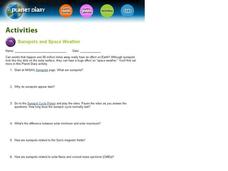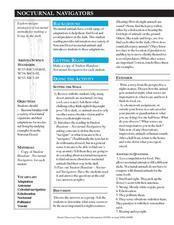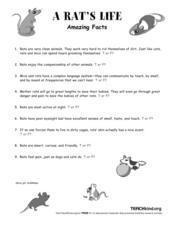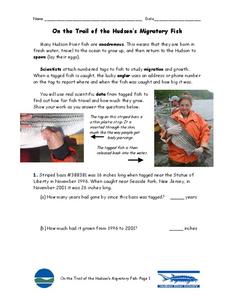Curated OER
Inductive Reasoning
In this science activity, students read two example problems that include a problem, observation, and conclusion. Students also answer 2 questions using inductive reasoning.
Curated OER
Clay
What is made from clay? First graders draw and illustrate four objects or things that are made out of clay. They then list two more things made out of clay in the box provided.
Curated OER
Reaction Types Worksheet
In this reaction types worksheet, learners complete a graphic organizer by determining what type of reaction is shown in the example given.
Curated OER
Parts of an Insect
In this science worksheet students will label the parts of an insect. Students will synthesize a list of insect names for each letter of the alphabet.
Curated OER
Identify And Classify
In this consumer awareness worksheet, students learn that hazardous household products have words that identify the risk. Students view 54 photos of common household substances. Students sort them into piles according to the hazard risk.
Curated OER
Rocks and Minerals
Take young geologists on an exploration of the collection of rocks and minerals that we call Earth with an upper-elementary science lesson. Through a series of class discussion and hands-on investigations, students learn about the...
Curated OER
Worksheet 24 Spring 1996
In this math worksheet, students find all the vectors in three dimensional space that have the length of 4. Also, the first and third components are the same. Finally, the second component is the sum of the first and third components.
Biology Junction
Enzymes
Many people know enzymes help with digestion, but few realize enzyme production decreases with age, making it more difficult for bodies to digest certain foods. A activity offers 28 fill-in-the-blank and short-answer questions over...
Curated OER
An Introduction to Modern Economics
Practice reading comprehension with this informational economics worksheet. Learners read a 2-page explanation of the beginnings of modern economics and how it plays a role in society. This reading discusses natural, human and capital...
Wind Wise Education
Understanding Electric Power Generation
You mean the electricity does not come from the switch? As a class and in small groups, learners explore the sources of energy used to generate electric power. Worksheets guide groups into choosing a future electricity generating...
Curated OER
Sunspots and Space Weather
This assignment is out of this world! It is an online worksheet about sunspots and solar cycles, a sort of WebQuest if you will. Links to two NASA websites and spaceweather.com are written into the questions so that your aspiring...
Curated OER
Pollution and Environmental Studies- Daily Water Use
In this environmental studies worksheet, students create a data table to discover how much water each person uses on a daily basis and what it is used for. They complete a post activity to make and test solutions for pollution using a...
Curated OER
Raven Chapter 11 Guided Notes: How Cells Divide
Take your advanced biology learners across the great divide: where cells divide, that is! Although it was created as a chapter reading guide, having your class complete this worksheet is not only appropriate, but also highly valuable in...
Desert Discoveries
Nocturnal Navigators
Young biologists take a look at some of the unique ways that nocturnal animals survive in the dark. After reading a terrific student handout which is embedded in the plan, learners work together to answer questions about what they have...
Curated OER
A Rat's Life
Here is a two-page worksheet on rats and mice. Learners answer nine true/false questions about rats and mice, then compose answers to seven short-answer questions about these two rodents. Finally, they must compose a fictional story...
Curated OER
Stoichiometry
In this stoichiometry worksheet, students solve thirty problems using the process of stoichiometry to find moles, molecules, and masses of substances in chemical reactions. Students balance chemical equations, find limiting reagents and...
Curated OER
AP: Chapter 10: Photosynthesis
AP biologists or college-level botanists consider in-depth details of the photosynthetic process. They examine the structures in a leaf and the roles that they play. They label neat and colorful diagrams of photosystems and electron...
Desert Discoveries
Sonoran Desert Predators and Prey
Here is a fabulous activity the animals found in the Sonoran Desert. Learners classify these animals as predators, prey, or both! They take a look at the many adaptations that these animals utilize to help them find food, and avoid...
Curated OER
Venus
Looking for a good worksheet to help teach about the planet Venus? This worksheet is for you! An excellent photograph of Venus accompanies three paragraphs of text. Learners answer five multiple choice questions based on what they've...
Curated OER
Cell Cycle
This mitosis worksheet targets AP-level biology courses. Learners identify the roles of kinase, cyclin, and CDKs, as well as describing external signals for growth. Large and colorful diagrams are displayed within the worksheet for high...
Curated OER
Using Your Teeth
In this Using Your Teeth activity, students read information about teeth and then complete the labels for a diagram about teeth. Students also think about the differences between human and animal teeth and design an information leaflet...
Curated OER
On the Trail of the Hudson's Migratory Fish
Ever wonder how scientists track fish underwater? Your class can learn how with this informative worksheet. First, they will read a paragraph about androgynous fish, tagging, and data analysis. Then, your scientists must answer five...
Creative Chemistry
pH Curves and Indicators
Glimpse how pH changes during an acid-base titration by examining graphs. It contains graphs of pH changes and a chart summarizing what indicator to choose for different changes. This is not truly a learning exercise, but a handy handout...
Curated OER
Raven Chapter 12 Guided Notes: Sexual Reproduction & Meiosis
Young biologists define reproduction vocabulary terms, answer critical-thinking questions, label a diagram of the human life cycle, and complete a chart comparing mitosis to meiosis. This is a well-balanced instructional activity. Even...























